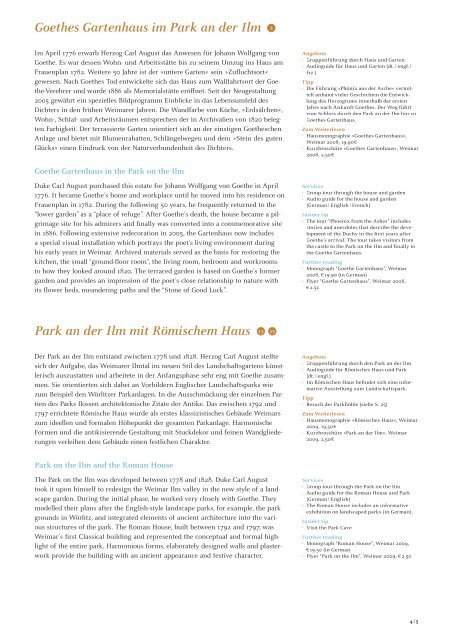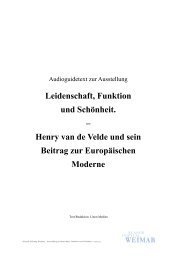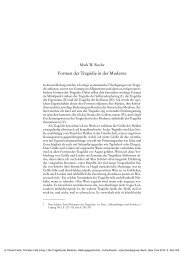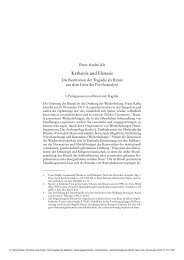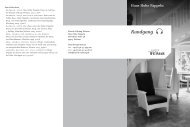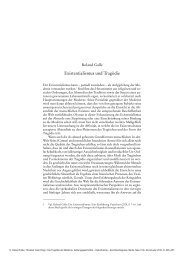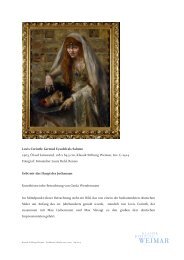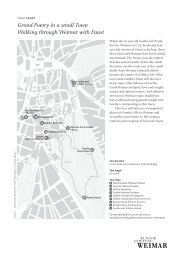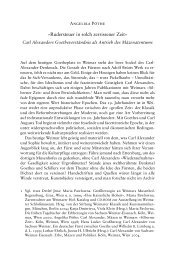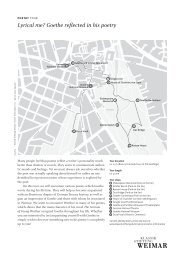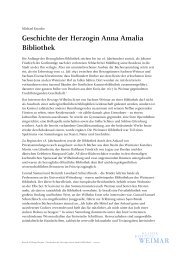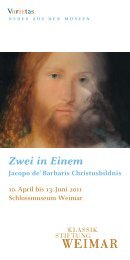Programme, Führungen und Vorträge zum Kosmos Weimar
Programme, Führungen und Vorträge zum Kosmos Weimar
Programme, Führungen und Vorträge zum Kosmos Weimar
Sie wollen auch ein ePaper? Erhöhen Sie die Reichweite Ihrer Titel.
YUMPU macht aus Druck-PDFs automatisch weboptimierte ePaper, die Google liebt.
Goethes Gartenhaus im Park an der Ilm<br />
3<br />
Im April 1776 erwarb Herzog Carl August das Anwesen für Johann Wolfgang von<br />
Goethe. Es war dessen Wohn- <strong>und</strong> Arbeitsstätte bis zu seinem Umzug ins Haus am<br />
Frauenplan 1782. Weitere 50 Jahre ist der »untere Garten« sein »Zufluchtsort«<br />
gewesen. Nach Goethes Tod entwickelte sich das Haus <strong>zum</strong> Wallfahrtsort der Goethe-Verehrer<br />
<strong>und</strong> wurde 1886 als Memorialstätte eröffnet. Seit der Neugestaltung<br />
2005 gewährt ein spezielles Bildprogramm Einblicke in das Lebensumfeld des<br />
Dichters in den frühen <strong>Weimar</strong>er Jahren. Die Wandfarbe von Küche, »Erdsälchen«,<br />
Wohn-, Schlaf- <strong>und</strong> Arbeitsräumen entsprechen der in Archivalien von 1820 belegten<br />
Farbigkeit. Der terrassierte Garten orientiert sich an der einstigen Goetheschen<br />
Anlage <strong>und</strong> bietet mit Blumenrabatten, Schlängelwegen <strong>und</strong> dem »Stein des guten<br />
Glücks« einen Eindruck von der Naturverb<strong>und</strong>enheit des Dichters.<br />
Angebote<br />
· Gruppenführung durch Haus <strong>und</strong> Garten<br />
· Audioguide für Haus <strong>und</strong> Garten (dt. | engl. |<br />
frz.)<br />
Tipp<br />
· Die Führung »Phönix aus der Asche« vermittelt<br />
anhand vieler Geschichten die Entwicklung<br />
des Herzogtums innerhalb der ersten<br />
Jahre nach Ankunft Goethes. Der Weg führt<br />
vom Schloss durch den Park an der Ilm hin zu<br />
Goethes Gartenhaus.<br />
Zum Weiterlesen<br />
· Hausmonographie »Goethes Gartenhaus«,<br />
<strong>Weimar</strong> 2008, 19,90 €<br />
· Kurzbroschüre »Goethes Gartenhaus«, <strong>Weimar</strong><br />
2008, 2,50 €<br />
Goethe Gartenhaus in the Park on the Ilm<br />
Duke Carl August purchased this estate for Johann Wolfgang von Goethe in April<br />
1776. It became Goethe’s home and workplace until he moved into his residence on<br />
Frauenplan in 1782. During the following 50 years, he frequently returned to the<br />
“lower garden” as a “place of refuge”. After Goethe’s death, the house became a pilgrimage<br />
site for his admirers and finally was converted into a commemorative site<br />
in 1886. Following extensive redecoration in 2005, the Gartenhaus now includes<br />
a special visual installation which portrays the poet’s living environment during<br />
his early years in <strong>Weimar</strong>. Archived materials served as the basis for restoring the<br />
kitchen, the small “gro<strong>und</strong>-floor room”, the living room, bedroom and workrooms<br />
to how they looked aro<strong>und</strong> 1820. The terraced garden is based on Goethe’s former<br />
garden and provides an impression of the poet’s close relationship to nature with<br />
its flower beds, meandering paths and the “Stone of Good Luck”.<br />
Services<br />
· Group tour through the house and garden<br />
· Audio guide for the house and garden<br />
(German | English | French)<br />
Insider tip<br />
· The tour “Phoenix from the Ashes” includes<br />
stories and anecdotes that describe the development<br />
of the Duchy in the first years after<br />
Goethe’s arrival. The tour takes visitors from<br />
the castle to the Park on the Ilm and finally to<br />
the Goethe Gartenhaus.<br />
Further reading<br />
· Monograph “Goethe Gartenhaus”, <strong>Weimar</strong><br />
2008, € 19.90 (in German)<br />
· Flyer “Goethe Gartenhaus”, <strong>Weimar</strong> 2008,<br />
€ 2.50<br />
Park an der Ilm mit Römischem Haus<br />
13 15<br />
Der Park an der Ilm entstand zwischen 1778 <strong>und</strong> 1828. Herzog Carl August stellte<br />
sich der Aufgabe, das <strong>Weimar</strong>er Ilmtal im neuen Stil des Landschaftsgartens künstlerisch<br />
auszustatten <strong>und</strong> arbeitete in der Anfangsphase sehr eng mit Goethe zusammen.<br />
Sie orientierten sich dabei an Vorbildern Englischer Landschaftsparks wie<br />
<strong>zum</strong> Beispiel den Wörlitzer Parkanlagen. In die Ausschmückung der einzelnen Partien<br />
des Parks flossen architektonische Zitate der Antike. Das zwischen 1792 <strong>und</strong><br />
1797 errichtete Römische Haus wurde als erstes klassizistisches Gebäude <strong>Weimar</strong>s<br />
<strong>zum</strong> ideellen <strong>und</strong> formalen Höhepunkt der gesamten Parkanlage. Harmonische<br />
Formen <strong>und</strong> die antikisierende Gestaltung mit Stuckdekor <strong>und</strong> feinen Wandgliederungen<br />
verleihen dem Gebäude einen festlichen Charakter.<br />
Angebote<br />
· Gruppenführung durch den Park an der Ilm<br />
· Audioguide für Römisches Haus <strong>und</strong> Park<br />
(dt. | engl.)<br />
· Im Römischen Haus befindet sich eine informative<br />
Ausstellung <strong>zum</strong> Landschaftspark.<br />
Tipp<br />
· Besuch der Parkhöhle (siehe S. 25)<br />
Zum Weiterlesen<br />
· Hausmonographie »Römisches Haus«, <strong>Weimar</strong><br />
2009, 19,50 €<br />
· Kurzbroschüre »Park an der Ilm«, <strong>Weimar</strong><br />
2009, 2,50 €<br />
Park on the Ilm and the Roman House<br />
The Park on the Ilm was developed between 1778 and 1828. Duke Carl August<br />
took it upon himself to redesign the <strong>Weimar</strong> Ilm valley in the new style of a landscape<br />
garden. During the initial phase, he worked very closely with Goethe. They<br />
modelled their plans after the English-style landscape parks, for example, the park<br />
gro<strong>und</strong>s in Wörlitz, and integrated elements of ancient architecture into the various<br />
structures of the park. The Roman House, built between 1792 and 1797, was<br />
<strong>Weimar</strong>’s first Classical building and represented the conceptual and formal highlight<br />
of the entire park. Harmonious forms, elaborately designed walls and plasterwork<br />
provide the building with an ancient appearance and festive character.<br />
Services<br />
· Group tour through the Park on the Ilm<br />
· Audio guide for the Roman House and Park<br />
(German | English)<br />
· The Roman House includes an informative<br />
exhibition on landscaped parks (in German).<br />
Insider tip<br />
· Visit the Park Cave<br />
Further reading<br />
· Monograph “Roman House”, <strong>Weimar</strong> 2009,<br />
€ 19.50 (in German)<br />
· Flyer “Park on the Ilm”, <strong>Weimar</strong> 2009, € 2.50<br />
4 | 5


